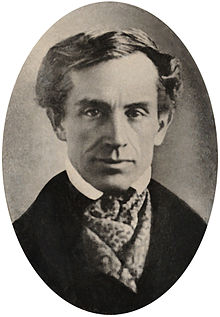Samuel Morse
Samuel Finley Breese Morse (April 27, 1791 – April 2, 1872) was an American inventor. He was the first person to make a telegraph with only one wire, and also helped come up with the idea of Morse code.

Since the 1700s, there were different types of telegraphs being made, but they were hard to use because they had several wires. (The first telegraph ever built had 26 wires, which made it almost impossible to use.) Morse spent years trying to build one with only one wire, and managed to do it in 1836.[1] Morse and his assistant made a code with "dots and "dashes", which were two different types of "clicks" on the telegraph.
Morse's invention made it possible to quickly communicate with people far away, and many telegraph lines were built. A telegraph line using his invention was built between Washington, D.C. and Baltimore in 1844. By the 1860s, there were telegraph lines all around North America, and in 1866, a telegraph line was built across the Atlantic Ocean.[2]
Life
changeSamuel F. B. Morse was born in Charlestown, Massachusetts
Morse was a painter before he was an inventor. He was a professor of art at New York University. He wanted to do some paintings that were going to be done at the United States Capitol, but was not chosen to do them. He was so disappointed that he gave up painting.[3]
Morse was a devout Christian. The first message he sent on his 1844 telegraph line was "What hath God wrought?", which comes from the Book of Numbers in the Bible.
He died in New York City on April 2, 1872.
References
change- ↑ "Inventor of the Week: Archive". web.mit.edu. July 2002. Retrieved November 26, 2011.
- ↑ "Samuel F. B. Morse Home Page". memory.loc.gov. Retrieved November 26, 2011.
- ↑ McCullough, David (September 2011). "Samuel Morse's Reversal of Fortune | History & Archaeology |". Smithsonian Magazine. Archived from the original on April 19, 2013. Retrieved November 26, 2011.